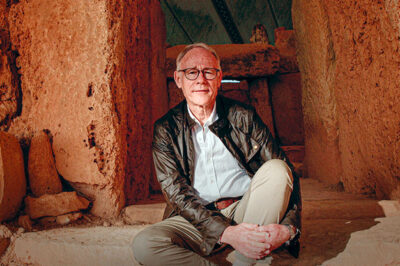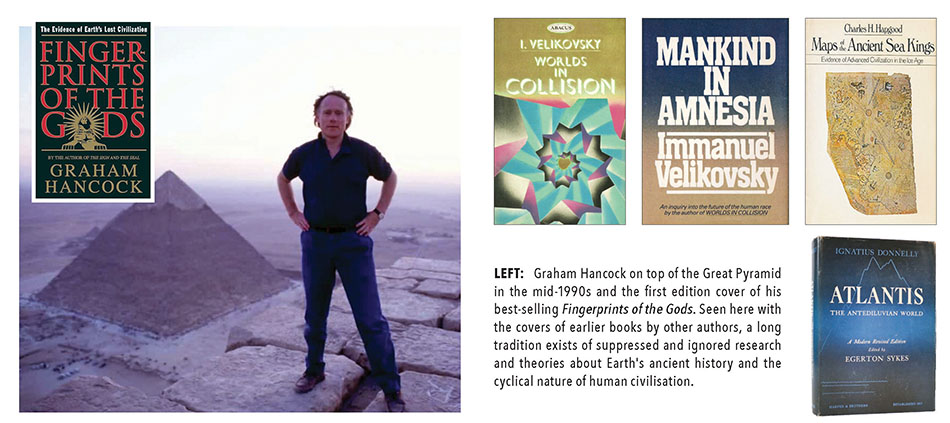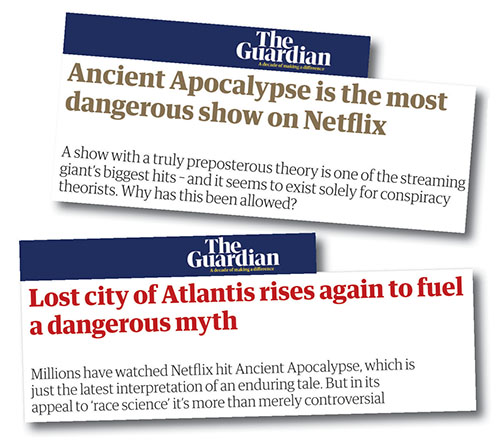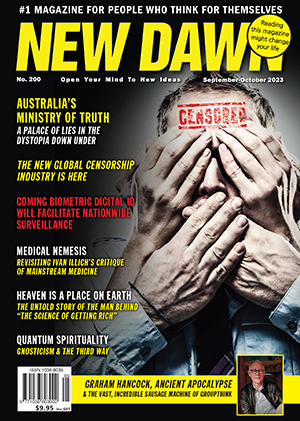From New Dawn 200 (Sept-Oct 2023)
I would rather have questions that can’t be answered than answers that can’t be questioned.
– Richard Feynman
November 2022 saw the release of Graham Hancock’s controversial documentary series Ancient Apocalypse on streaming giant Netflix.
The backlash was immediate, hysterical and, perhaps, even insightful.
Now that the dust has settled, what can be discerned from the vilification, defenestration and immolation of Hancock and his theories?
Starting with his 1995 book Fingerprints of the Gods, Graham Hancock has carved a sizeable career casting doubt, asking questions and proposing alternate theories in opposition to the mainstream consensus on archaeology and ancient history.
More recent volumes like the 2002 Underworld: The Mysterious Origins of Civilization (which focused on alleged evidence of cities and civilisations lost in the roughly 400-foot sea level rise since the end of the last Ice Age, approximately 12,000 years ago) or the 2015 tome Magicians of the Gods: The Forgotten Wisdom of Earth’s Lost Civilization (which explores the hypothesis that around 12,000 years ago [and more recently] large fragments of a comet struck the North American and European ice caps, resulting in massive, almost species destroying, deluges of melted glacial water).
Both books (and many others from Hancock) present large caches of fascinating, incongruous and unconventional evidence that question the foundations of conventional views and academic assumptions about pre-history and the acceptable framework of archaeology. But Graham Hancock is hardly alone in questioning the received structure of mainstream history.
There is, in fact, a long subterranean tradition of ‘catastrophism’, hypotheses and beliefs about the cyclical nature of human civilisation and the greater history of Earth itself.
Immanuel Velikovsky’s 1950 book Worlds in Collision created a firestorm of controversy upon initial release. Velikovsky proposed a mythic reconstruction of Earth’s ancient past, whereby the legends and fables of the Bible and other scriptural and cultural accounts might be compared, reconciled, and evaluated to illuminate our periodically unstable world.
Velikovsky has been credited as having founded modern ‘catastrophism’, the study of Earth and civilisation’s cyclical nature. Worlds in Collision was a bestseller upon release, but it was alleged that the scientific community had attempted to suppress the book and refused Velikovsky any forum to debate his detractors in the scientific world. Five years later he published Earth in Upheaval to respond to the outcry from those in the orthodox camp.
Mankind in Amnesia was published in 1982 (posthumous to Velikovsky’s 1979 death) and proposed a kind of species-wide post-traumatic amnesia in response to our cataclysmic past – the author linking mankind’s history of war, aggression and barbarism to his turbulent mindset.
In 1966, Velikovsky associate Alfred De Grazia published The Velikovsky Affair, a detailed and compelling recounting of all the controversies that swirled around the ‘catastrophic school’ of scientific and historical revisionism.
Concurrently, Charles H. Hapgood advanced his theory of catastrophic shifts in the Earth’s poles and crust in 1958’s Earth’s Shifting Crust: A Key to Some Basic Problems of Earth Science (which came with a foreword by Albert Einstein). Later, in 1966, Hapgood wrote Maps of the Ancient Sea Kings: Evidence of Advanced Civilization in the Ice Age in which he studied anomalous maps (like the Piri Reis map of 1513) that appeared to suggest ancient knowledge of lower sea levels and an ice-free Antarctica.
Indeed, across the late-1960s and 1970s, a multitude of writers (prolific scribes like Rene Noorbergen and Andrew Tomas come to mind) questioned orthodox history and sketched antediluvian relics and societies in one form or another.
Perhaps the earliest, in the modern era, had been Ignatius Donnelly’s 1882 classic Atlantis: The Antediluvian World.
In fact, beliefs in a cycle of cataclysm and renewal, of hubris and arrogance leading to a catastrophic downfall, are at least as old as Plato’s ‘Republic’ (circa 375 BCE) – which records the oldest ‘legend’ of Atlantis that survives to this day.
So, while undermining the constructions and institutions of conventional history and archaeology may not be new, what was it about Graham Hancock’s Ancient Apocalypse that triggered such a violent, fire-breathing response?
Ancient Apocalypse – “Dangerous”
Examples of that hyperventilating media scorn are plentiful, but the UK’s The Guardian so often serves as a convenient temperature-check on fevered, delirious outrage and posturing, radical establishmentarianism. Handily, The Guardian printed not one but two howling tirades against Ancient Apocalypse in the space of one week.
The most darkly entertaining was penned unironically by media critic Stuart Heritage, whose headline screamed: “Ancient Apocalypse is the most dangerous show on Netflix.”
Dangerous? It might be easy to describe Graham Hancock as ‘studious’, ‘reasonable’, ‘professorial’ even ‘bookish’ but ‘dangerous’ (i.e., ‘deadly’, ‘fatal’ or ‘threatening’)? Really?
One is, of course, entirely free to view Hancock’s thesis as fanciful, unlikely or even wrong, but to ascribe ‘danger’ to an alternative archaeological hypothesis seems to be the most delirious kind of mania and absurdity.
It actually gets worse. The Guardian sub-headline continues: “A show with a truly preposterous theory is one of the streaming giant’s biggest hits – and it seems to exist solely for conspiracy theorists. Why has this been allowed?”
“Allowed.” Yes, he actually said it.
How dare this bespectacled destroyer of academic smugness and media comfort zones, this avenging angel, this soulless wrecker of echo chambers and laptop-class talking points be “allowed?”
Here, presumably, Heritage appeals to parental authorities, kindergarten teachers, high school prefects, yard monitors (anybody!) to do something… anything. Indeed, Heritage seems to be demanding Hancock be ‘blacklisted,’ ‘cancelled,’ ‘removed,’ ‘deleted’ or even ‘disappeared’ for his crime of heresy.
Astounding.
An infantile scream for bloody ideological revenge.
Heritage’s penultimate paragraph makes it clear that Graham Hancock is guilty of Thoughtcrime:
“That’s the danger of a show like this. It whispers to the conspiracy theorist in all of us. And Hancock is such a compelling host that he’s bound to create a few more in his wake. Believing that ultra-intelligent creatures helped to build the pyramids is one thing, but where does it end? Believing that election fraud is real? Believing 9/11 was an inside job? Worse?”
Stuart Heritage and The Guardian are such prisoners of dogma, such willing inmates of the propaganda panopticon, that they dare not see their violent hypocrisies in the damning black mirror. ‘Election fraud’ is a delusion (except when Authority says Russia did it). ‘False flag’ attacks a mirage (except when The Media declares The Enemy guilty). In their view, every mainstream narrative should be unassailable, questions or criticisms never to be “allowed.”
Just a few days later, on 27 November, Robin McKie, ‘Science Editor’ at The Guardian, swooped down for the kill with his piece entitled, “Lost city of Atlantis rises again to fuel a dangerous myth.”
“Millions have watched Netflix hit Ancient Apocalypse, which is just the latest interpretation of an enduring tale. But in its appeal to ‘race science’ it’s more than merely controversial.”
Shamelessly, McKie continues, accusing Graham Hancock of “white supremacist” ideas and “racism” recklessly unaware or uncaring (as the media so often is) that such defamatory claims have real world implications and effects on real people. While media behemoths may indeed be untouchable, real people are not.
Indeed, in subsequent interviews, Hancock has spoken of the personal hurt and professional damage such vilification caused him. It’s hard to imagine The Guardian would care.
McKie produces some convenient cookie-cutter academic to intone gravely, “They strip indigenous people of their rich heritage and instead give credit to aliens or white people” while never noting that throughout its eight episodes Ancient Apocalypse never once actually mentions ‘aliens’ or race. Such is the sloppiness and disregard on display in The Guardian’s ‘journalism’ that basic ‘fact-checking’ or simple respect for your subject is essentially non-existent.
Finally, Robin McKie can’t help but go for the low blow:
“Then there were the Nazis. Many swore by the idea that a white Nordic superior race – people of ‘the purest blood’ – had come from Atlantis. As a result, Himmler set up an SS unit, the Ahnenerbe – or Bureau of Ancestral Heritage – in 1935 to find out where people from Atlantis had ended up after the deluge had destroyed their homeland.”
As JR Leach points out in his humorous piece on Off-Guardian:
“Of course, going by this logic, we should really do away with Christianity as well. God in general, in fact. Perhaps we should cancel Volkswagen and Wagner too. Nazis also brushed their teeth and wore shoes, I believe, neither of which shall I be taking part in from this day onwards, just to be sure.”
Indeed, we should probably identify Plato as a retrospective proto-National Socialist if we were to follow McKie ‘argument’ to its logical endpoint.
For another example, one need simply return to the second paragraph of Stuart Heritage’s hit piece where he asserted (falsely) that the opening moments of Ancient Apocalypse featured Hancock in conversation with gatekeeping bad-boy Jordan Peterson (it was actually an entirely different legacy media pariah/competitor, Joe Rogan). But seriously. Any ‘heretic’ will do. The edit and correction were so slapdash that they still bear the signs of faulty syntax. It now reads: “In quick succession, during the pre-show sizzle reel, we are treated to a clip of the show’s host Graham Hancock being interviewed by Joe Rogan.” ‘In quick succession’ implies a plural of ‘clips’ where there is now only one, such was the haste and contempt of this yellow ‘journalism’.
Media Mass Formation Psychosis
Across establishment rags, hipster organs and boutique bourgeois bromides alike – from Slate, The Conversation and Scientific American to The New Republic, The Nation, The Independent and Australia’s anaemic ABC network – spewed a unified chorus of Two Minute Hate.
Hancock was mugged and dragged kicking into the Culture Wars.
But why?

Why the mild-mannered Graham Hancock? And why now?
That is the sixty-four-million-dollar question.
Like some cornered, enraged beast, desperate to defend its turf, desperate even for survival: the legacy media and its sycophants spat bilious globules of venom. Of course, they did.
Whether co-ordinated or reflexive (we’ll likely never know), that fevered monster, the giant octopus of consensus reality, marshalled all its antibodies (dare I say – its white-blood cells) to ward off infection of the body ideological.
While ‘The Hancock Affair’ is just one of many examples, it is a particularly instructive one. The hysteria, the untethering from any kind of objective reality, the bile and scorn uniformly directed toward an innocent scholar, simply asking questions and poking conventions, can tell us a great deal.
Reminiscent of the theories of Mattias Desmet (as expounded in his book The Psychology of Totalitarianism), the last three years (in particular) have seen a mass traumatic event that drove segments of a frightened population even further into the arms of authority. People prone to ‘free-floating anxiety’ (arguably, partially, or even wholly, a result of incessant media weaponization of fear and confusion) are liable (generally unknowingly) to engage in what Desmet calls “mass formation” – a kind of totalitarian mass psychosis that identifies dissent or disagreement as a ‘dangerous’ ‘pernicious’ foreign influence that must be attacked and destroyed to preserve the righteous social organism.
Individuals such as Heritage and McKie (unknowingly, or at least with minimal bidding from their editors) respond precisely as ‘mass formation’ dictates, in spasms of frothing anger and blind rage. Emotionally, they have committed themselves to the ‘mass’ and see ‘the other’ as an existential threat. In this case, the ‘mass’ is conventional history and ‘social justice’ as supported, indoctrinated and embodied by all the ‘respectable’ and conventional instruments of state, media and education.
Writing in a New Republic piece entitled, “The Strange and Dangerous Right-Wing Freakout Over Ancient Apocalypse” from December 2022, Jason Colavito inadvertently illuminates his own, and his group, mass formation:
“Ancient Apocalypse sits alongside Tucker Carlson, Joe Rogan, and the so-called ‘intellectual dark web’ in casting doubt on expertise, privileging emotion over evidence, and bending history to ideological ends – in this case, making common cause with the right against academia, science, and the very idea of shared reality. That it did so on one of the biggest media platforms in the world should give us all pause.”
Hancock is no longer just a journalist, presenting different theories and unconsidered evidence, now he is a heretic who joined other heretics (Carlson, Rogan et. al.) in threatening the body with danger. Colavito identifies emotionally and practically with the ‘mass’ (or ‘The Blob’ as James Howard Kunstler calls it) and instinctively rises to battle, just as the body’s antibodies attack infectious threats.
Indeed, he continues: “History isn’t just about what happened in the past. It’s also about whose stories get told and how we think about them.” Colavito speaks about “shared reality” as if there is only one correct and acceptable vision of the past and present, one party or ‘mass’ definition of what is appropriate to think and to verbalise.
It is, unfortunately, witheringly totalitarian language delivered with all the confidence and righteousness of someone who does not know history at all. Colavito has simply internalised the desires and dictates of the ‘mass’ so completely that they are entirely invisible to himself and his peers. He is a loud, proud foot soldier for control and Groupthink.
What we are witnessing appears to be a kind of ‘Project Year Zero’ – the purging of traditions, history, debate, discussion, dissent and dialogue and its replacement with a new unassailable framework of history and ideology – a ‘Great Reset’ if you will. And those who question or resist are identified, shamed and un-personed by the ‘mass’.
This totalitarian mindset has, essentially, overwhelmed almost all organs of the state and culture. In essence, it appears we have a ‘collaborator class’ throughout the institutions of the media, academia and politics. Confident, well-rewarded and secure in their superannuated echo chambers, ‘the collaborators’ march forth, the ‘Red Guards’ of the 21st century, like busy bees animated by ‘struggle sessions’, ‘purity tests’ and ‘purges’.
Pure in doctrine and safe in the group.
But if the ‘collaborator class’ are indeed collaborators, who, exactly, are they collaborating with?
The Caligula Class & Their Collaborators
Reading, again, Robert Graves’ masterful I, Claudius, I was struck by how oddly familiar the historical figure of Caligula was. A paragon of power, madness, delusion and depravity, Caligula has become a byword for power without responsibility, action without consequences, bloodlust and corruption without end. But Caligula was just one man – he was nothing and would have been entirely impotent without a class of collaborators, a stratum who milked his madness and power while they could – who laughed and celebrated his crimes, deluded that they were forever immune from his wrath and mania.
Today, we do not have one Caligula. We have, perhaps, a thousand. Most of them likely unknown to the public and popular culture – but their frontmen are obvious – and often, unsurprisingly, immune for their crimes and corruptions, at least for decades. Harvey Weinstein, Jeffrey Epstein and his long-time best buddy (tech billionaire and ‘philanthropist’) Bill Gates, are simply the most visible pus to escape the boil – pillars of depravity, the platinum-plated flotsam that has floated to the surface of a vast, dank pond. Captains of industrial scale abuse that masquerades (with almost complete media fealty) as ‘philanthropy’ and ‘expertise’.
The scab hides an entire ‘Caligula class’.
Their ill-gotten, manufactured fortunes washing through foundations and think tanks, grants and gratuities, funding opportunities and photo ops – animating an entire media and political class to do their bidding. There were always plenty glad to seek Caligula’s favour, marshalled by fear or ambition. Today is essentially the same.
Though the Caligula class and their collaborators are indeed powerful, with almost all the present levers of state and media at their command, now is not a time for despair. Their power is transitory and illusory, magnified by technology and modern magics – their grasp fragile as evidenced by their hysteria when a ‘heretic’ appears on one of ‘their’ platforms, in ‘their’ terrain, ‘their’ backyard.
Perhaps, ‘their’ day is almost done. The final, ear-bursting shrieks of outrage and mendacity almost over.
Meanwhile, a humble scholar, a gentleman journalist – Graham Hancock – recently caught in the cultural crossfire, is now gone on a six-month research sabbatical. Preparing, quietly and methodically, to face again the dragon of power, depravity and ignorance.
Good luck, fair Graham…
© New Dawn Magazine and the respective author.
For our reproduction notice, click here.





